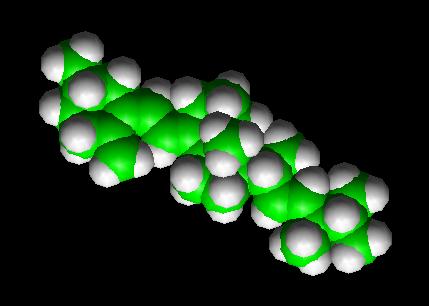Vitamin D Molecule

Vitamin D is a fat soluble vitamin that contributes to the maintenance of normal levels of calcium and phosphorus in the bloodstream.
Often known as calciferol.
Forms of Vitamin D:
- Vitamin D1: lamisterol
- Vitamin D2: ergocalciferol (made from ergosterol)
- Vitamin D3: cholecalciferol (made from 7-dehydrocholesterol)
- Vitamin D4: dihydrotachysterol (22:23-dihydrovitamin D2)
- Vitamin D5: irridated 7-dehydrositosterol
Vitamin D, sunlight and skin color
There are two forms of the vitamin molecule. The Vitamin D2 molecule is derived from ergosterol in the diet, whereas vitamin D3 molecule is derived from cholesterol via 7-dehydrocholesterol. Ultraviolet light (from sunlight) is responsible for the production of both forms of the vitamin. However, in certain parts of the world with limited sunlight there is the possibility that the quantity of vitamin D is not always sufficient. To prevent this possibility milk is now fortified with vitamin D2. A deficiency of vitamin D leads to rickets which is a softening of the bones owing to faulty mineralization.
The active form of the vitamin D molecule is calcitriol which is synthesized from either D2 or D3 in the kidneys. Calcitriol binds to a protein transcription factor which can regulated gene expression. The outcome is the maintenance of calcium and phosphorus levels in the bone and blood with the assistance of parathyroid hormone and calcitonin.
Because the level of calcitriol synthesis ultimately depends on exposure to sunlight, dark-skinned people who live in sun-poor regions historically would often lack vitamin D. Protection from vitamin D deficiency, and thus rickets, might be one reason light-skinned humans evolved in cloudier regions.
Pioneering work in isolating the vitamin D molecule and determining its role in rickets was done by Edward Mellanby in 1918-1920.
Vitamin D deficiency is also known to cause:
- Osteoporosis: A condition characterized by fragile bones.
- Osteomalacia: A bone-thinning disorder in adults that is similar to rickets.
And Vitamin D malnutrition also may be linked to chronic diseases such as cancer (breast, ovarian, colon and prostate), chronic pain, weakness, chronic fatigue, autoimmune diseases like multiple sclerosis and Type 1 diabetes, high blood pressure, mental illnesses--depression, seasonal affective disorder and possibly schizophrenia--heart disease, rheumatoid arthritis, psoriasis, tuberculosis and inflammatory bowel disease.
Who may need extra vitamin D to prevent a deficiency?
Older people (greater than age 50) are thought to have a higher risk of developing vitamin D deficiency). The ability of skin to convert vitamin D to its active form decreases as we age. The kidneys, which help convert vitamin D to its active form, sometimes do not work as well when people age. Therefore, some older people may need vitamin D from a supplement.
Newborn infants who are exclusively breastfed may require vitamin D supplements. Breastmilk does not contain significant levels of the vitamin, and although infants could receive this vitamin from sunlight, it is usually not recommended that small infants be exposed to sunlight in the levels required to produce a sufficient amount of vitamin D. Infant formula is generally fortified with vitamin D, so this requirement only applies to breastfed infants.
Vitamin D food sources
Fortified foods are the major dietary sources of vitamin D. Prior to the fortification of milk products in the 1930s, rickets was a major public health problem. In the United States milk is fortified with 10 micrograms (400 IU) of vitamin D per quart, and rickets is now uncommon in the US .
One cup of vitamin D fortified milk supplies about one-fourth of the estimated daily need for this vitamin for adults. Although milk is fortified with vitamin D, dairy products made from milk such as cheese, yogurt, and ice cream are generally not fortified with vitamin D. Only a few foods naturally contain significant amounts of vitamin D, including:
- fatty fish such as salmon, cooked, 3.5 oz, 360 IU;
- mackerel, cooked, 3.5 oz, 345 IU;
- sardines, canned in oil, drained, 3.5 oz, 270 IU;
- eel, cooked, 3.5 oz, 200 IU;
- fish oils such as cod liver oil, 1 Tbs., 1,360 IU; and
- egg yolk (one whole yolk, 25 IU).
Sources: National Institutes of Health, National Osteoporosis Society
External links
- Medical Encyclopedia article(http://www.nlm.nih.gov/medlineplus/ency/article/002405.htm) (note: not a public domain resource)
- Food Sources of Vitamin D (http://ibscrohns.about.com/library/fda/blvitd4.htm).
- Vitamin D information (http://www.talkwellness.org/vitamind.html)
Vitamins
| Biotin(B7) |
| Riboflavin (B2) |
| Vitamin D |
| Vitamin K |
| Vitamin E |
| Vitamin A |
| Folic Acid (B9) |
| Thiamine (B1) |
| Vitamin C |
| Niacin (B3) |
| Pyridoxine (B6) |
| R-panthothenate |